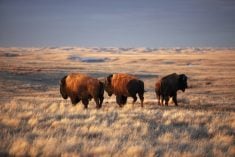It is hard to imagine that 40 years have slipped by since I scribbled my first piece for Grainews in 1976. It was “Nitrogen: When, what kind and how much to apply.” Today we would call it the 3 Rs: Right time, right source and right rate. The 4th R, right placement, was yet to come.
At that time I was in mid-career and Grainews was a young kid just a few years old. The editor was John Clark, who was a classmate of Don Rennie, head of soil science at the University of Saskatchewan at that time. John asked Don to write articles for Grainews. My job was half extension so Don asked me if I would like to take it on. It was a grand opportunity and I jumped at the chance.
Read Also

Claas brings 1000 Series SP forage harvesters to Canada
In mid-August, Claas unveiled its new line of Jaguar forage harvesters at an event in Visalia, California, deep in the heart of that state’s dairy region.
In the early days, Grainews was published by United Grain Growers, a farmer-owned grain company formed in 1917. Grainews was considered an extension piece by UGG to serve the needs of farmers and there was NO advertising — UGG plus subscriptions paid the bills. Many of the writers were actual stubblejumpers who had some skin in the game.
For more info on early Grainews see my column of January 7, 2014 when the headline was “Grainews from the beginning.”
Prairie Agriculture: 1976 to 2016
The past four decades have seen many changes in the way we do our farming and the way we interact with our suppliers of inputs and purchasers of our products.
The 1970s were the glory years. Grain prices shot up quickly, rainfall was mostly good and farmers were making money hand over fist. The use (and price) of inputs advanced rapidly and land prices skyrocketed.
Summerfallow was still a major land (mis)use but new crops and practices were appearing.
In Saskatchewan, one of the major developments was the appearance of Dr. Al Slinkard in the Crop Development Centre at the U of S. He was a pulse breeder from the U.S. Pacific Northwest. He established peas and lentils as major crops in many areas. Much of the farm net worth from the clay belt of west-central Saskatchewan has come from lentils. This year (2016) is an exception. The excess rain did a number on lentils but it will still be a major crop in that area in future.
The 1980s and 1990s brought sharp declines in both production (dry years) and prices (other areas of the world were producing enough to satisfy most markets).
The 1988 drought was particularly devastating with almost no crop in many areas. I remember driving from Hanna, Alta., to Saskatoon in August and remarking that two old 90 Massey combines could have handled any crops good enough to combine in all that area.

But the big killer was interest rates — as high as 18 to 20 per cent for a time. Debt on high-priced land bought in rosier times could not be serviced with the crop returns and much land was lost and turned back to creditors. In the late 80s land prices dropped like a stone as distress land was forced on the market. The back page of many issues of the Western Producer was filled with distress land of Farm Credit Corporation one week and the Royal Bank the next week.
The dry years brought on serious soil drifting and spurred farmers to try experiments with zero till. “There has to be a better way” was a refrain by early adopters John Bennet, Biggar, Sask., and Doyle Wiebe, Langham, Sask., to pick two of many. The early June zero-till seeding demonstrations hosted by Saskatchewan Soil Conservation Association (SSCA) were a sellout for many years. The Manitoba/North Dakota (ManDak) Zero Till Association was also very prominent in promoting zero till.
Zero till really took off when seeders capable of the job were designed — and most of that was in farm workshops and small local implement manufacturing firms. Jim Halford, Pat and Norbert Beaujot, Morris and Bourgault come to mind.
Summerfallow gradually faded away. The other factors that led to continuous cropping and zero till was the availability of annual legumes and Roundup Ready canola to allow a cereal, pulse and oilseed rotation.
As summerfallow and excessive tillage faded away so did soil drifting. When a windy day in May comes along I have to come from my Dundurn farm to Saskatoon to see land blowing on new urban developments.
The demise of summerfallow had been predicted much earlier. A local weekly paper to which I subscribe, The Rosetown Eagle had this quote “it is safe to say that the day of the summerfallow in Western Canada is over.” The date: June 12, 1924 as provided in “Looking Back, June 16, 2014!”
The 2000s started off with a huge flop. 2001 was very dry on my farm (3.7″ rain May through July and only 12 bushels/acre peas). 2002 was also a bust year but rains too late for that crop did set up a reserve for 2003. For the next few years we lived “hand to mouth” for soil moisture, which was the yield-limiting factor most years.
The very large snowmelt of 2005 started to replenish soil moisture and the 20 inches of rain in 2010 sealed the deal. Since then, in our area at least, moisture has ceased to be the limiting factor. The irrigation pivots serviced by Blackstrap Lake have been an impediment to farming operations in recent years.
Big crops, good prices and ready markets have spawned huge changes and led to huge farms with land bought at huge prices. When the cycle will end is unknown but end it will and more huge changes and restructuring will occur.
My Grainews columns: 1976 to 2016
I have a file with tearouts of the actual articles as they were published for all 40 years. What follows is a bit of the flavour of a selection of the columns over four decades.
Wheat: protein grading
The glory years of the 1970s saw columns on protein grading of wheat, beginning with the November, 1976 column. At the U of S we had considerable research showing that growing high-protein wheat was a matter of porking on enough N to get near to the peak yield for the moisture supply of any given year.
The protein theme carried on until October, 2000, issue when the headline was “We are finally getting paid right for wheat protein.” The “right” system was a small bump in price for each 0.1 per cent bump in protein.
Nitrate down the well
Nitrate in subsoil, groundwater and wells was a research interest in my early years and carried on into the 1990s. Nitrate in well waters causes blue baby and can be fatal, so it is taken very seriously. The column was repeated every few years to make sure that young couples moving to a new farm with an old well made sure it was tested before using for baby formula.
In the U.S. today, nitrate in surface water from runoff and tile drains of intensively farmed corn land is a big problem. The great Mississippi delivers too much nitrate to the Gulf of Mexico — bad news. Just this week I received notice of a webinar to discuss ways and means to remove nitrate from tile drains before it is released to the river system.
Soil salinity
In the 1970s and early 1980s soil salinity was a huge problem and the topic for several articles. Our lack of knowledge spawned a large research project at the University of Saskatchewan from 1982 to 1994. We determined that artesian discharge was the main culprit and the only solution was drainage and leaching. In many dryland areas rainfall is usually not adequate for leaching, although recent years have changed that.
By the time we finished the project the rainfall cycle had switched to dry and much salinity was reduced naturally. But, the super-wet years of the past decade have juiced it up big time. Early on in the cycle this column predicted that salinity would rear its ugly head and it has. Most requests for public speaking are for the soil salinity topic.
Soil moisture
The first Stubble Soil Moisture Map created anywhere in North America was for Saskatchewan as of November 1, 1978. That map appeared in the February 1979 issue of Grainews.
In fall 1988 we almost did not print a map because it was almost all coloured RED, the colour for Very Dry. We made a special category “Summerfallow Not Full” to accommodate the special situation.
Fast forward to 2010 when the Stubble Soil Moisture Map for the three Prairie provinces included a “Super Wet” category to accommodate those areas with excess rain that resulted in a serious rise in the water table. Stuck combines are prima facie evidence of high water table.
My favourites
What follows are a few examples of special pieces I enjoyed penning and readers seemed to appreciate.
September 1998. “What a difference a rain makes: 24 little hours.” The piece was all about a three-day 3.4-inch rain ending June 18, 1998, that was the difference between a crop and not that year.
March-April 2002. A three-part series on precision agriculture. The technology part of precision ag has grown fast, but the agronomy not so much. That is why widespread adoption has been slow. I still think that pretty pictures of past crops is not enough to do the job.
December 2003. “There is more in the farmer than there is in the land.” The quote came originally from Doane’s, an early U.S. private ag consulting firm. It recognized the importance of the few ounces of brains under a farmer’s hat that determines success or failure in a very tough business.
January 14, 2008. “Bread and beer.” When wheat fetches $6/bu. the farmer’s share of a loaf of bread is $0.11. If it should ever hit $10/bu. we would get $0.18 from a loaf. Beer is easy. For each $1/bu. we get one brown penny for each bottle of beer. Now that they have abolished the penny I guess we are completely out of luck!
March 10, 2010. “Drainage is not a dirty word.” And December, 2010. “Farming and n eighbours.” When those two pieces were penned I did not see any connection. Just today (October 5, 2016) I had a visit with a Saskatchewan government official I have great respect for. He pointed out that the Conservation and Development (drainage) districts that exist in Saskatchewan were formed at a time when farms were much smaller and neighbours worked together more. It is true. In these super wet years drainage is one of the biggest issues in many areas and getting groups formed to deal with it is a tough job.
October 2012 and March 2013. “Earthworms.” As I saw more and more earthworms when digging for seed in spring I spent summer 2012 reviewing the literature on the topic. The October piece put out what I had found and included a small survey for readers to fill out and return. And return they did, in spades. Thanks again readers. But, I still have had no success in convincing soil biology types to get out and research earthworms in the field. We still do not know even who they are let alone what we need to do to see that they stick around. So sad!
March, 2013. “The truth about Lake Winnipeg.” That piece was a lot of work. The bottom line is that 68 per cent of the phosphorus in Lake Winnipeg comes from the Red River and a big chunk of that is from south of the 49th.
February 2014. “The beauty of the harvest.” This was a lot of fun to do. After that, I received a CD from Murray Pask, Atwater, Sask., showing four old combines he restored. They had a family and neighbours combine day and had a lot of fun using the old dolls to rub out a few bushels of wheat. City slickers will never understand the thrill of “bringing in the sheaves.” The equipment has changed a lot but the thrill of the chase is timeless.
March/April 2015. “New wrinkles on phosphorus.” It has been fun to see the changes in our thinking about P fertilization. Old rules that I had used are completely out the window and we now know we need to think in a longer time frame. In my defence, I have said for years that P is an investment in the land. Thanks to colleagues, we now have some numbers to put behind that statement.
Thank you, and the future
In my 37 years of scribbling on these pages there has been a long line of editors. John Clark, Roger Olson, Peter Perkins, Andy Sirski, Dave Bedard, Cory Bourdeaud’hui, Jay Whetter, Lyndsey Smith and now Leeann Minogue. I can honestly say that I have never had a serious disagreement with any of the editors and have always had complete freedom. Thanks to all who have fixed up my blunders and made it easier to read.
As well, the changes in ownership have been seamless from my vantage point. Never have I been told to remove or change anything because it may not fit with the thinking of the owners or advertisers. Freedom is what it is all about.
A sincere thank you to the readers and to the advertisers. Without them Grainews would not exist.
None of us know what the future holds. As long as I continue to receive feedback from readers, and Grainews does not kick me out, I will scribble for a bit yet. Hopefully I will know when time is up. The first priority for 2017 is to get an updated photo on the page. I hate to continue to mislead folks with the youthful photo that I have been reluctant to change.
















